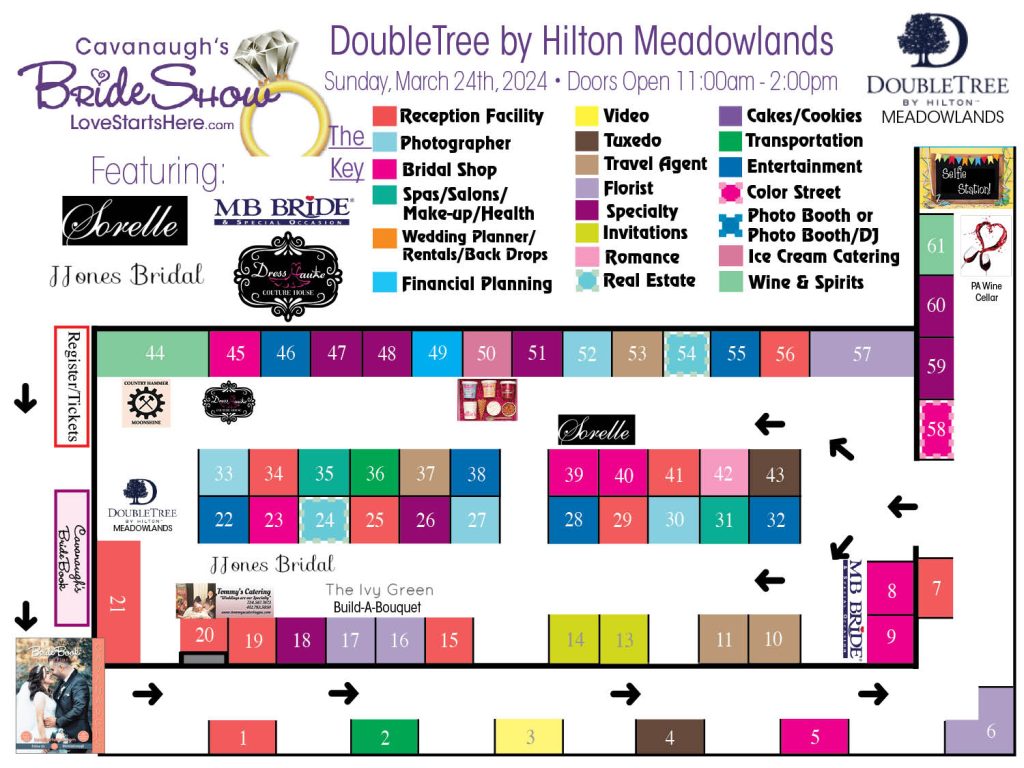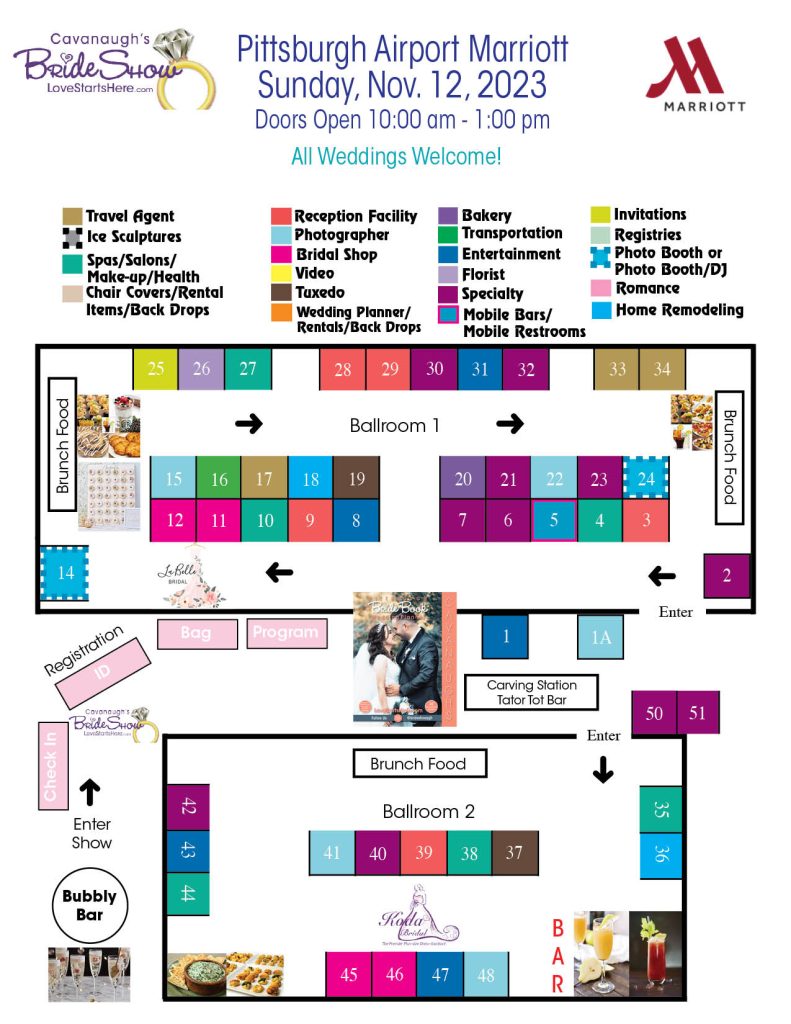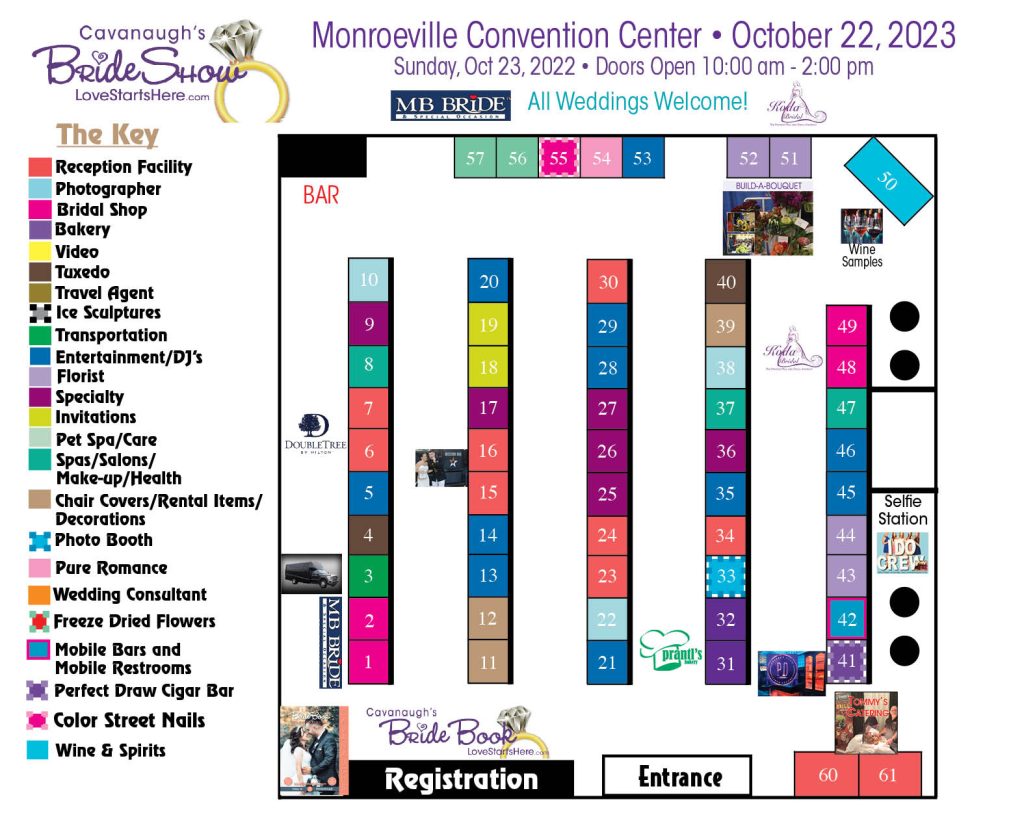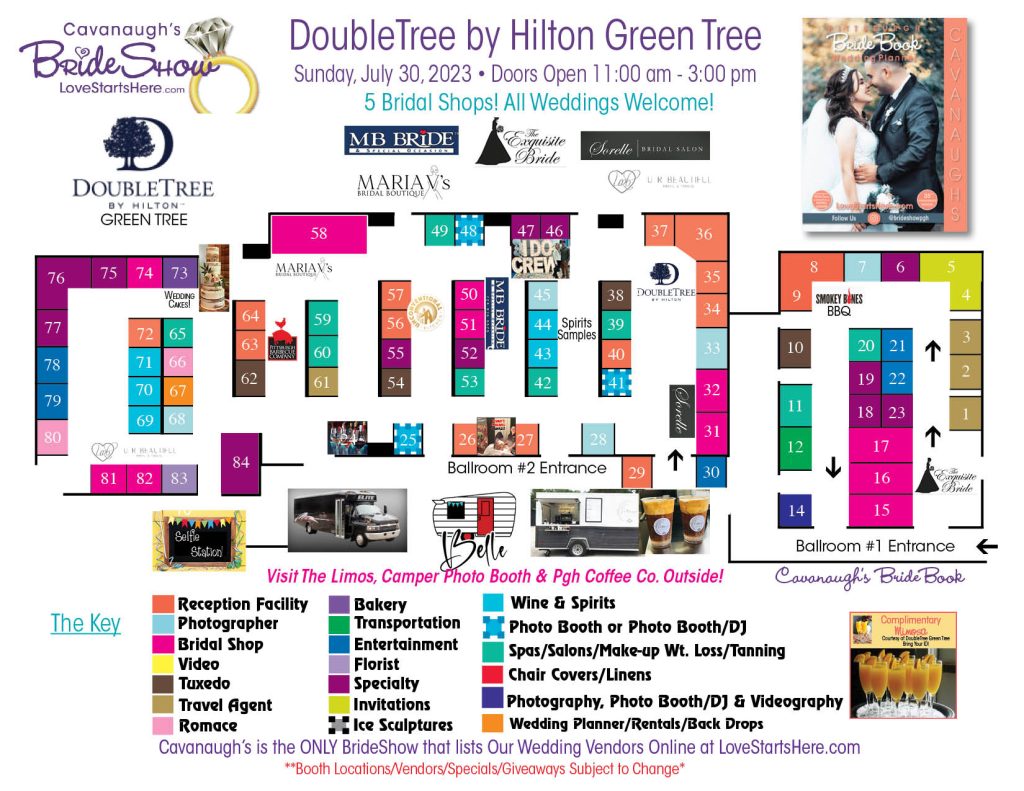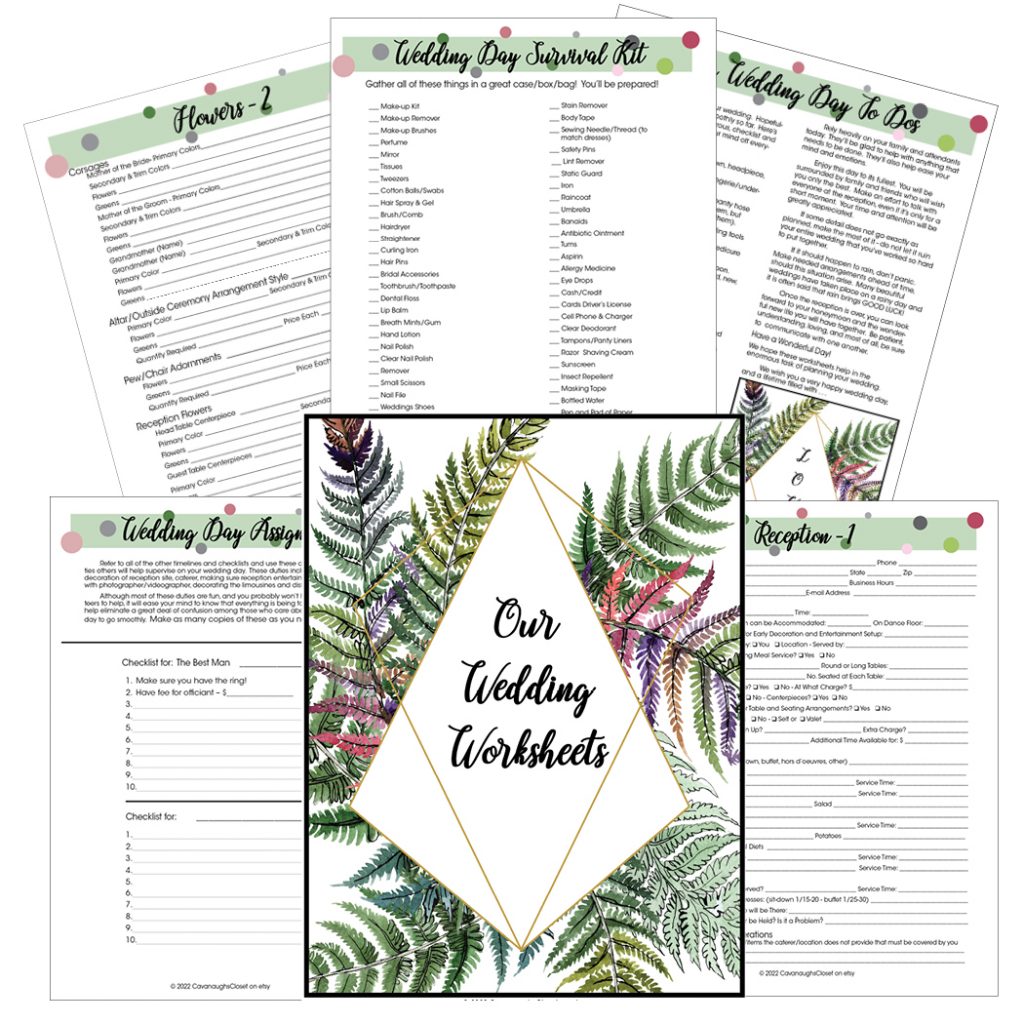Bridal Attire
Topic: Attire for Bride, Attendants, Mothers, etc.
Timeframe: ASAP
Pittsburgh Area Bridal Stores – Wedding Dress Business Listings
Although it’s worn only once, the bridal gown has long been the symbolic focal point of weddings.
As times change, so do the options for choosing your wedding dress. Whether you buy off the rack or have a dress custom made, shop consignment shops or assemble your own wedding-day outfit, it all comes down to fit. Does the dress fit you, your budget, and your style of wedding?
Choosing a Bridal Boutique
Buying a wedding gown involves more than the cost of the dress. It entails important services such as alterations, fittings, cleanings, and transport. Don’t be too quick to save a few dollars only to spend it later when you need alterations or other adjustments due to poor service. Shoddy alterations can come apart with a quick movement or tug of a heel. You won’t have time to repair the damage later.
It’s best to ask recently married friends for their suggestions regarding bridal boutiques or department stores. How were they treated? Was the service efficient and helpful? Did everyone seem knowledgeable about the bridal industry and the products they sold? Did the dress arrive as promised? Were the alterations performed to satisfaction?
The Better Business Bureau can tell you of any unsettled disputes with former customers. In addition, you might call the dress manufacturer. If that manufacturer has never heard of the shop you mentioned, you can assume that they will be using a third party who has an account with the manufacturer to obtain your dress.
A full-service boutique will offer first-quality gowns, undergarments, steaming and pressing services and a professional seamstress.
Choosing a Bridal Gown
When choosing the style of your gown, keep in mind the type of wedding you and your fiancé have decided upon. Will your wedding be very formal, formal, semi-formal, or informal? Also consider the time of day of your ceremony and the season of the year. Your bridal professional will help you in narrowing down y our choices, depending on your style of wedding. Choose a dress that complements your coloring as well as your figure type.
Take your mother or a close friend along when trying on gowns. You will need the opinion of someone who has your best interests in mind.
Your bridal salon will help you choose an appropriate gown for the style of ceremony you are having. Cathedral or chapel length trains are usually prominent in very formal or formal weddings. Gowns with a train photograph beautifully and have a breathtaking effect when walking down the aisle. Some gowns may be fashioned with a detachable train which can be removed for the reception. If your train is not detachable, make sure it can be bustled or held up in one way or another. You will want to be comfortable at the reception and be able to dance with ease.
A semi-formal wedding dress may be a shorter design such as tea length or street length, or just a simple floor length gown without a train.
If you’re having an informal wedding, almost anything goes. A street length dress is usually worn and may be any color you choose. Flowers should still be included in the form of a small nosegay or a shoulder or wrist corsage.
Choosing Your Veil
Once you’ve chosen your gown, you may now decide on the headpiece and veil. These should complement the dress as well as your hairstyle and face.
If your gown has beautiful back detail, you may want to go with a shorter veil or a sheer longer style allowing your dress to show through. A veil can even take the place of a train. It may be detachable for the reception or attached to your wrist for easy movement. Small pillbox hats may be worn for any style of wedding from formal to informal, and may again be trimmed with a small veil and ornamental pieces. If choosing a hat, consider the brim carefully. Large brimmed hats tend to cast heavy shadows over the bride’s face which can seriously impact the quality of your photographs.
Your veil may have a plain edge finish or be trimmed in pearls or lace to enhance your gown. Be sure the headpiece is comfortable and can be securely attached. Always try the headpiece on with your gown before purchasing to ensure a perfect look, and be sure to style your hair as you will wear it on your wedding day.
Wearing Your Mother’s Gown
If you’re lucky enough to be able to wear your mother’s gown or headpiece, be sure to have the dress properly cleaned, restored, and altered if needed. The laces and fabrics may have turned color slightly over the years. A professional dressmaker can usually restore or remodel a gown.
Often, an older headpiece just needs a few touch-ups and perhaps a new veil attached. Wearing an heirloom can add special sentiment to your wedding day, not only for you but for your parents and grandparents too.
Second-Time Weddings
A second time bride can choose as elaborate a gown and headpiece as she likes, in white or any other color. Etiquette still dictates that she not wear a veil, especially a blusher (symbolic of purity).
Custom Made Bridal Apparel
When choosing your bridal apparel, one option is to have your gown custom made. This is a very exciting option, in that you can be totally creative, and the end result can be the exact dress you’ve had in mind.
Most designers/dressmakers can work from a picture or drawing, or just start with an idea and go from there. Specialty fabric shops feature a wide range of formal and bridal fabrics, laces, and trims. These stores track new trends, often visiting New York once a month. Finding a store with knowledgeable sales help is important. If you don’t know a designer or seamstress, bridal fabric stores can often make referrals.
Always confer with a professional seamstress before purchasing patterns or fabrics, as she/he is an expert and will have some useful tips and suggestions.
Having your dress custom made means you will have a custo m fit, excellent workmanship, fabrics and laces of your choice, and often a one-of-a kind style for yourself and your attendants. A couple of fittings are usually necessary, and always remember to wear the same undergarments and shoes as you will for your wedding. If you are having the bridesmaids’ dresses made, it is best to have the same person do the entire party. This ensures each dress will be assembled and finished exactly the same way.
Most bridal seamstresses can also create the headpiece of your choice. Any length of veil can be made with many different types and layers of illusion to choose from.
Keep in mind your seamstress can create the mothers’, grandmothers’, and flower girl’s dresses too, along with any other special projects you have in mind. For example, bowties and cummerbunds can be made from the attendant’s fabric to ensure a perfect match for the groomsmen.
Allow your seamstress as much time as possible, giving her/him a bare minimum of eight to twelve weeks. More time may be needed if fabric must be special ordered.
Wedding Shoes
When choosing your shoes, comfort should take priority. Shop for you shoes late in the day, after your feet have swollen. You should also consider the design and fabric of your dress. Keep your shoe material as close to that of the dress as possible; choose satin shoes for gowns of shiny fabrics, shoes of crepe for gowns with a matte finish, and lace-covered shoes for a lacy gown. Look for ornamentation or beadwork that matches or complements your gown. Remember that your shoes may need to be dyed. Be sure to take in an actual swatch of your gown fabric(s) to match.
If you do not have your shoes in time for your gown fitting, wear a shoe with the same sized heel. If you don’t see a shoe you like, ask the sales consultant. Many salons don’t display samples of every shoe they carry. Additional shoes can often be ordered. While shoe shopping, consider purchasing a match ing handbag.
Be sure to break in your shoes well. Wear them around the house for several days before the ceremony. Scuff the soles on the pavement outside so you don’t slip on carpeting or waxed floors.
Undergarments
In addition to the gown, headpiece, and veil, you will need the proper undergarments. These can include panties, bra or bustier, slip, petticoat and/or crinoline, stockings and garter. Purchase your undergarments, slips prior to the first fitting. Be certain all are comfortable. If you need a strapless bra and are unused to wearing one, wear it around the house to get used to it. If the dress has a straight skirt, shop for a full length slip to wear underneath it. If you have chosen a dress with a fuller skirt, consider whether you need a crinoline or if a full petticoat will do. Consider, too, the waist of the gown. Many slips are styled to fit under specifically designed waists. Have your slip, petticoat or crinoline hemmed two to three inches shorter than your gown. That way, it will not accidentally show while you are walking down the aisle or dancing.
Select hosiery to complement your dress. Sheer hose in white, ivory or cream are more becoming under your gown than shades that blend with your skin tone. Go as fancy as you want with your hosiery. Consider white lace hose, hose with bows or all-over floral patterns, or hose embellished at the ankle with embroidery and/or jewels. Be sure to have at least one extra pair on hand in case of an emergency.
When purchasing a garter, be sure to check its fit. If it is too tight, it will become very uncomfortable. If it is too large, it may slide down your leg. You may want to purchase two garters, as your groom will throw one to the single male guests.
Accessories
Gloves of various styles and lengths can be worn with many gowns. If you do want to wear gloves, mention your interest in wearing gloves to your sales consultant early in your gown shopping.
When select ing jewelry, take a photograph of you in your gown if possible. It is best to have both a full-length photo as well as a good upper body shot.
Jewelry should be selected with care. The design of the gown will dictate the choice of jewelry. Earrings are almost always worn. They should complement the overall look of the bridal ensemble: the gown, headpiece, veil, and your hairstyle. In fact, earrings may be the only jewelry needed if your gown is high-necked and long sleeved, or the bodice is elaborately detailed. If the gown exposes the neck and arms, consider purchasing matching earrings, necklace, and bracelet.
Keep scale in mind. Petite brides should choose jewelry with a more delicate look, while taller and more full-figured brides can consider more dramatic jewelry.
This is also a good time to look at jewelry for your attendants. Crystals come in many different colors, or choose pearl or iridescent jewelry if you have a difficult color to match.
If you don’t own a fine handkerchief, now is the time to consider purchasing one. It can be wrapped around the bouquet or tucked in a sleeve. Either way, a handkerchief is an elegant way to wipe away a happy tear or two.
Don’t forget a wrap, particularly if you are getting married during the late fall, winter, or early spring. If you don’t own an evening wrap, ask if you can borrow one from a close friend. You can also rent one, or purchase a beautiful shawl or cape. Both can be worn after the wedding.
Apparel for Bridal Attendants
When choosing dresses for your attendants, keep in mind color, style, and cost. Opt for a style that will complement your gown as well as the girls in your bridal party. The length of the bridesmaids’ dresses need not be the same as your gown, but should never be longer. If choosing tea length for the bridesmaids, be sure they are hemmed the same distance from the floor, despite any differences in their heights. Use the tallest bridesmaid to determin e the most flattering length, and have the others hemmed accordingly. The honor attendant’s dress is usually a different shade than the rest of the bridal party, although it doesn’t need to be.
Take your bridal party along and ask for their opinions. Remember, they are wearing and paying for their own dresses and they should be comfortable with them. If you have a large wedding party, you may have to go with a majority decision, as sometimes it’s hard to get so many to agree on the same dress. All dresses should be ordered from the same store at the same time if possible. This ensures you will receive the same dye lot on all of the dresses.
Younger Attendants
Junior bridesmaids usually wear an identical style to that of the bridesmaids, if possible. If you are having a flower girl, she may dress like the bridesmaids or wear a similar style in the same or complementing color. Another option is a white or off white dress trimmed with ribbons or bows of the wedding colors.
If you wish to have the attendants’ shoes dyed, be sure to ask for fabric swatches to take along. All shoes should be dyed at the same place if possible to ensure color uniformity.
And remember, always ask for fabric swatches to show the florist, baker, photographer, mothers, etc.
Preserving Your Gown
To properly preserve your wedding gown it should receive the attention of a professional gown cleaner at the earliest possible opportunity. Once stains, both visible and invisible, begin to oxidize, they become much more difficult to remove. Find a professional gown cleaner who is skilled in handling delicate materials. Regular dry cleaning may loosen and/or discolor glued on trims and pearls, so choose your cleaning professional with care.
Be sure to point out any stains that you know of when dropping off your gown for cleaning. If you know what the stain is, let the cleaner know. Keep in mind that you should not treat any stains on your dress yourself . Never rub a stain; when you rub across the weave of a fine fabric, you are more likely to set the stain further. If, and only if, a stain is water soluble (foods in general), you may want to dab it with clear, cool water to remove the worst of it. Leave the rest to a professional.
Packing Your Gown
The bodice of a cleaned gown can be stuffed with white, acid-free tissue paper. The gown is then usually wrapped with more white, acid-free tissue, and placed in an acid-free box. Another alternative is wrapping the gown in a clean, white sheet and storing it in a cedar chest. Should you decide to store your gown on a hanger, it is a good idea to sew straps, slightly shorter than the bodice, to the waistline. Attaching these straps to a fabric padded hanger will relieve the pressure on the shoulders from the weight of the skirt.
Fabric covered metal buttons, pins, and sponge shoulder pads should be removed from the dress and wrapped separately; they can be safely stored in the gown box as long as they are not touching the fabric. Metal trims can oxidize and leave permanent rust stains on the fabric. Similarly, sponge padding can deteriorate and cause yellowing of the fabric.
The headpiece and veil may be extremely fragile, and may show age well before the gown. These too should be wrapped in white, acid-free tissue, and stored in the box with the gown.
Storing Your Gown
Never store your gown in plastic. Plastic wrap releases gases that can actually speed the yellowing and deterioration of the fabric. Cover it with a white sheet or muslin instead.
Keep your gown in a cool, dry place. Basements and attics are not recommended due to the significant changes in temperature and humidity these areas experience. Often, a guest bedroom, den or office closet is the ideal spot.
You should periodically inspect your gown. Stains that were missed at the time of cleaning could appear later. If you inspect your gown every year or two, you will be able to have these hidden stains treated before they become a major problem.
By preserving your wedding gown, you will have a cherished keepsake and an heirloom for your daughter and /or granddaughter to wear years from now.
Questions for Your Professional
1. How long will it take the dress(es) to come in once they’re ordered?
Some dresses take months to come in, so shop early. You will also need extra time for fittings and alterations.
2. What do alterations cost?
Get as specific an estimate as possible so you will know what to expect and fit it in your budget. Also ask about alterations to attendants’ dresses. The pricing may be different on their dresses.
3. Will my gown be steamed and pressed for pick up?
This is very important to have a professional handle this. Ask if there is an extra charge for this service.
4. Will the attendants’ dresses be pressed for pick up?
Ask if there is an extra charge for this. If there is, it is usually worth it as many fabrics are very tricky to steam.
5. What happens if I change my mind?
Ask what happens if you either cancel the wedding, postpone it or change your mind and want another dress style. Deposits are usually not returned and you may be required to pay for the entire dress.
6. Can extra fabric be ordered?
You may want extra fabric for various things including your flowergirl’s dress.
Be sure to check out Bridal Attire Worksheet under: For Brides: My Bridal Suite





 '
'


